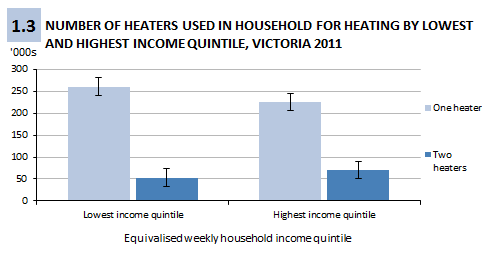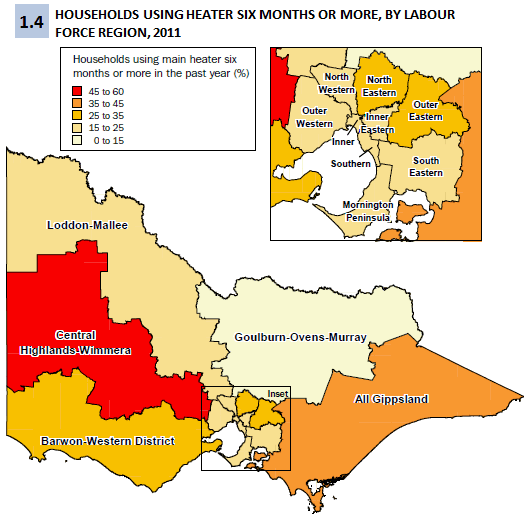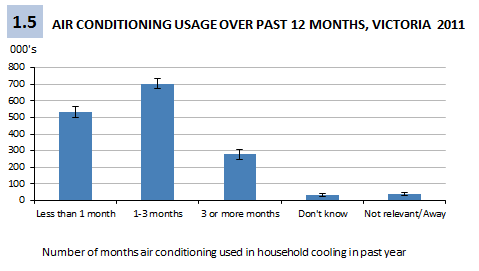HEATING AND COOLING
Most Australian homes need heating or cooling at some time of the year, and in some areas this accounts for up to 40% of household energy use (DCCEE 2012).
In Victoria the peak demand for electricity has been growing much faster than overall electricity demand. This has been attributed to Victorians increasing their use of air conditioning on very hot days (DPI 2012).
At cooler times of the year, Sustainability Victoria has estimated that for each degree the thermostat is increased in a dwelling, the costs of running the heater increases by up to 15%. Energy efficient homes can reduce heating costs by up to 30% (SV 2009).
This chapter discusses space heating and cooling in Victorian households.
HEATERS
In both Melbourne and Balance of Victoria there was a larger number of households using one heater than households using two heaters. Melbourne had 1.2 million households using one heater and 251,600 using two heaters. Balance of Victoria had 379,200 households using one heater and 158,700 households using two heaters.
For those households with one or two heaters, Inner Melbourne Statistical Region (SR) has the highest proportion of households with two heaters (25% or 27,100). The Inner Eastern Melbourne SR has the highest number of households with two heaters (45,500 or 22%).
Nearly a quarter (24%) of households in the highest income quintile had two heaters, compared with under one in five (17%) households in the lowest income quintile. In the lowest quintile 260,600 households used one heater and 53,000 households used two heaters. In the highest quintile 225,500 used one heater and 69,800 used two heaters (Figure 1.3).

Nearly three quarters (73% or 251,900) of Victorian households in the lowest income quintile used the heater for three months or more in a year. In the highest income quintile, 274,700 (80%) Victorian households used the heater for more than three months.
In Melbourne, 21% (or 324,100) of households used the main heater six month or more in the past year, compared with 29% (177,300) of households in Balance of Victoria.
The Central Highlands-Wimmera SR had the highest proportion (52%) of households using the main heater for six months or more (in a year), followed by All Gippsland SR (37%) and North Eastern Melbourne SR (32%) (Figure 1.4).

AIR CONDITIONERS
In Victoria 1.6 million or 74% of households use at least one air conditioner for cooling, and as with heaters, air conditioners are not uniformly distributed across these households.
Goulburn-Ovens-Murray SR had the highest proportion of households using at least one air conditioner for cooling (92%), the region with the lowest proportion of usage was Inner Melbourne SR (53%).
Couple families with dependant children had the highest usage of at least one air conditioner for cooling (82%), while persons living alone had the lowest usage (63%).
Dwellings with insulation were more likely to have used at least one air conditioner for cooling (80%), compared to dwellings without insulation (51%).
In Victoria 534,500 (34%) households used the air conditioner for cooling for less than one month in the past year (Figure 1.5). The most common usage of air conditioners for cooling in the past 12 months in Victoria was 1-3 months with almost half (44%) or 703,800 households. While 279,100 (18%) households used the air conditioner for cooling for at least three months or more.

Over a third (38% or 124,700) of one person households in Victoria used their air conditioner for less than one month, compared with a quarter (26% or 15,000) of six or more person households.
References
DPI (Department of Primary Industries) 2012, Managing electricity demand
<http://www.dpi.vic.gov.au/energy/electricity/managing-electricity-demand> last viewed 6th of June
DCCEE (Department of Climate Change and Energy Efficiency) 2012, Heating and Cooling
<http://www.livinggreener.gov.au/energy/heating-cooling> last viewed 14th June
SV (Sustainability Victoria) 2009, Running Costs Brochure
<http://www.resourcesmart.vic.gov.au/documents/Running_Costs_Brochure.pdf> viewed 19th June 2012
 Print Page
Print Page
 Print All
Print All
 Print Page
Print Page
 Print All
Print All